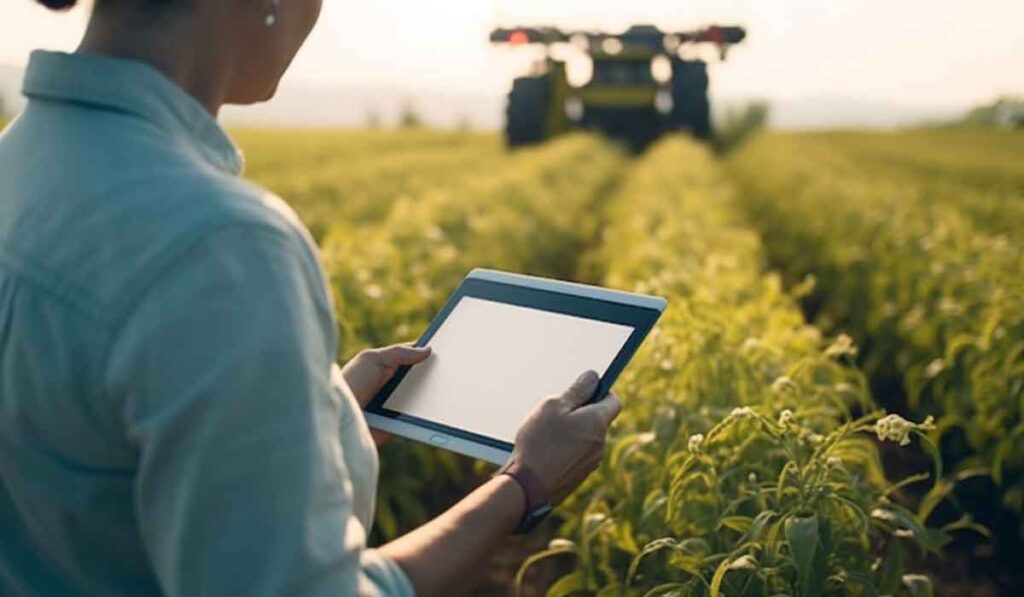Technology in agribusiness is an increasingly present reality.
Agriculture 4.0, driven by innovations such as the Internet of Things (IoT), Big Data, artificial intelligence and drones, is redefining agricultural production, making it more efficient, sustainable and profitable.
Check out the main technologies applied in agriculture and some of the challenges in promoting and applying these technological innovations.
The importance of technology in agribusiness
Technology is fundamental to agribusiness, as it helps increase productivity, improves sustainability and optimizes the management of agricultural operations.
With the use of automated machinery, sensors and intelligent irrigation systems, production becomes more efficient, resulting in higher yields and less waste of resources.
In addition, technological tools help minimize environmental impact, facilitate product quality control and reduce operating costs.
Technology also allows farmers to better adapt to climate change and access new markets, making the sector more competitive and prepared to face current challenges.
A survey by the University of Brasilia (UnB) recently revealed that more than 95% of rural producers use some kind of digital technology.
Robotics, the Internet of Things (IoT), drones, remote sensing and Artificial Intelligence are just some of the tools with applications in agribusiness, which shows that the activity has entered the digital economy once and for all.
In short, technology in agribusiness is essential to ensure the modernization and sustainability of the sector.
6 technologies applied in agribusiness
- Precision agriculture
Precision agriculture is a technological approach that uses geospatial data, sensors and other digital tools to manage crop variability within a farm.
Instead of treating a field as a homogeneous unit, this technique allows for the specific management of smaller areas, adjusting the application of inputs such as water, fertilizers and pesticides according to the real needs of each part of the land.
Application: precision agriculture collects and analyzes detailed data on the soil, weather conditions and plant growth, allowing farmers to make more assertive decisions.
Benefits: reduces the waste of resources, improves productivity, increases sustainability and allows for more efficient and profitable agricultural management.
- IoT sensors
IoT (Internet of Things) sensors are increasingly present in agribusiness, connecting equipment, plants and soil to the internet.
These devices capture real-time data on various conditions, such as soil moisture, temperature, nutrient levels and even plant health.
Application: IoT sensors are used to constantly monitor the conditions of crops and environments, providing information that can be accessed remotely by farmers and managers.
Benefits: they enable precise management of resources such as water and fertilizers, optimizing the use of these inputs, improving crop health and increasing production efficiency.
- Agricultural automation
Agricultural automation involves the use of autonomous or semi-autonomous machines and systems to carry out tasks that were previously labor-intensive, such as planting, irrigation, harvesting and spraying.
Application: replaces or complements human labor with intelligent machines that can operate with high precision and efficiency.
Benefits: reduces dependence on labor, increases productivity, improves the precision of agricultural operations and allows farmers to carry out large-scale tasks with less effort and greater speed.
- Drones
Drones have become an essential tool in agribusiness, providing a detailed aerial view of crops.
They are used to monitor plant health, map land, apply inputs such as pesticides and fertilizers and even assess crop yields.
Application: they offer a unique and detailed perspective on agricultural production, capturing data that would be difficult or impossible to obtain from the ground.
Benefits: improve crop monitoring, enable early detection of problems (such as pests and diseases) and increase efficiency and effectiveness in the application of inputs.
- Artificial Intelligence
Artificial intelligence in agribusiness is applied to analyze large volumes of data, predict trends, optimize agricultural operations and even develop new plant varieties.
AI can be used in conjunction with other technologies, such as IoT sensors and drones, to make more precise decisions.
Application: helps process and interpret complex data, enabling faster and more effective decision-making, as well as automating tasks that previously depended on human analysis.
Benefits: increases the efficiency of agricultural operations, improves the accuracy of crop forecasts, optimizes the use of resources and reduces the risks associated with agricultural production.
- Blockchain
Blockchain is a technology that enables the creation of immutable and transparent records of transactions.
In agribusiness, this technology is being used to trace the supply chain, ensuring that each stage of the process, from production to the end consumer, is recorded in a secure and transparent manner.
Application: facilitates the traceability of agricultural products, ensuring that consumers have access to reliable information about the origin and quality of food.
Benefits: increases transparency and consumer confidence, improves food safety, prevents fraud and allows producers and distributors to demonstrate the quality and sustainability of their products.
Application challenges
Despite the promotion of technology in agribusiness, there are some challenges that stand in the way of its full dissemination.
One of these is the lack of connectivity in the countryside. According to the Paths of Technology in Agribusiness survey, carried out by SAE Brasil and KPMG, 40% of respondents pointed to the difficulty of connection as a challenge to implementing technologies.
The high costs of investing in innovations is another factor that directly interferes with the implementation of technology in agribusiness. According to the aforementioned study, 31% of respondents mentioned this as a bottleneck to be overcome.
As a result, producers are increasingly having to resort to financing and loans. Rural credit provides financial institutions with resources for the normal expenses of agricultural production cycles, investment in goods and services, as well as expenses for marketing and industrializing production.
However, the legal aspects of obtaining rural credit can intimidate farmers, given the country’s legal and regulatory complexities and the particularities of their agricultural enterprises.
In this sense, having legal support helps simplify the process and ensures that it is carried out properly and efficiently.
Want to know more? In the guide “Rural credit: how can access be made easier for agricultural producers?”, you’ll learn about the possibilities that can help rural producers.is e empresários do agro a superarem as barreiras burocráticas e obter crédito de maneira mais eficiente.









